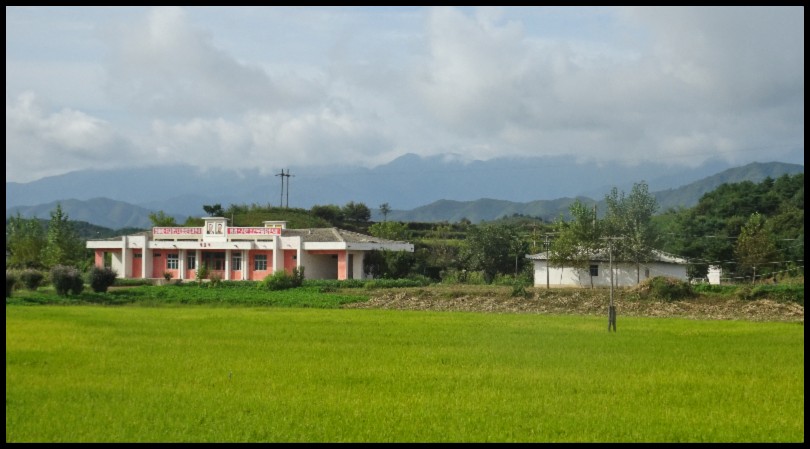After lunch at the Jangsusan Hotel it was off to school, the Kim Jong Suk Middle High School, one of the classier schools in the county, for gifted children. Gifted children in North Korea will always be from families with higher ‘songbun’ or status within the country – academic ability on its own being insufficient to meet the criteria.
Continue reading “The Kim Jong Suk Middle High School – Pyongsong”The Konji-Ri Revolutionary Site
Earlier in the morning we had visited the Victorious Fatherland Liberation War Museum (note that the link is to my 2014 visit review) in Pyongyang, an amazing museum by any measure, with its focus on the history of what foreigners refer to as the Korean War. On completing our tour of the museum, we jumped on our bus and headed north, on a ‘field trip’, to visit one of the sites mentioned by our guides in the museum. Our destination was the Konji-Ri Revolutionary Site which was the headquarters of the Korean People’s Army (KPA) for much of the duration of the Korean War.
Continue reading “The Konji-Ri Revolutionary Site”Pyongsong en route to Mt Myohyang
When I visited Mt Myohyang (best known as home to the International Friendship Exhibition) in 2014 we went there directly from Pyongyang and returned to the city with no stops en route, in either direction. In 2018 we had a few stops on the way up in South Pyongan Province and one, in North Pyongan Province, on our return to Pyongyang.
Continue reading “Pyongsong en route to Mt Myohyang”South Korea’s Sunshine Policy and the Mt Kumgang Tourist Region
In 1998 South Korean President, Kim Dae-jung, referenced one of Aesop’s fables, ‘The North Wind and the Sun’, in the creation of a new policy to improve relations with North Korea – essentially a shift from a failed coercion approach to one of co-operation. In the fable, the sun and the wind competed to remove a man’s coat. The wind blew strongly, but the man clutched his coat and kept it on. The sun shone warmly, and the man voluntarily took off his coat to enjoy the fine weather.
Continue reading “South Korea’s Sunshine Policy and the Mt Kumgang Tourist Region”En Route to Mt Kumgang
Leaving Wonsan, unlike most visitors who return west to Pyongyang or head north to Hamhung, we took the coastal road south to the Mt Kumgang region. This mountainous region borders with South Korea along the infamous demilitarised zone (DMZ) which is ironically one of, if not, the most militarised areas in the world. Tourist access to the DMZ on this side of the country is not possible.
Continue reading “En Route to Mt Kumgang”Samil Lagoon/ Lake – Mt Kumgang
En route back to our hotel from a spectacular hike to the Kuryong Falls we made a stop for a short walk to a viewing platform over Samil Lake.
Samil Lake is an 80 hectare freshwater lake, 9-13 metres deep, within the Mount Kumgang Tourist Region, in the south-eastern part of North Korea. It sits about 2 kilometres from the coast of the East Sea of Korea ( the Sea of Japan to non-Koreans) and 9 kilometres north-west of the border with South Korea.
Continue reading “Samil Lagoon/ Lake – Mt Kumgang”Kuryong Falls – Mt Kumgang Walk
Mount Kumgang, or the Kumgang Mountains, is a spectacular and stunningly beautiful mountain range, also referred to as the diamond or the thousand peak mountains. The mountains are located in the South East corner of North Korea, bordering with South Korea, on the other side of the infamous demilitarised zone. Between 2002 and 2008 hundreds of thousands of tourists from South Korea, in particular, visited the area. Since then it has very much reverted back the ‘the unseen North Korea’ visited by very few international tourists. While the mountains are a hikers delight and one could easily spend weeks here we were limited to an afternoon’s hiking to Kuryong Falls and a short visit to the Samilpo Lake (see seperate review) – but what a delightful afternoon it was.
Continue reading “Kuryong Falls – Mt Kumgang Walk”The Kumgangsan Chongnyon Railway Line – North Korea
Having left Wonsan our next stop was Mt Kumgang, three hours drive to the south, and to get there we drove along the (mainly) coastal National Highway 7 (AH6). For much of the way the highway runs in close proximity to the Kumgangsan Chongnyon railway line. Being a bit of a railway buff I enjoyed a bit of train station spotting en route to Mt Kumgang though sadly did not see any trains. In this post I share a few details on the line together with a few pictures of the stations I passed as well as a few other railway related snaps.
Continue reading “The Kumgangsan Chongnyon Railway Line – North Korea”An Evening Promenade – Jongdok Islet, Wonsan
Wonsan has been an important port since it was established in around 1880, primarily for trade with Japan. In 1919, during their occupation of the Korean Peninsula, the Japanese further developed the port and built a causeway/breakwater out to Jangdok Islet on which they built a lighthouse – for the protection of the harbour and shipping, mainly their own.
Continue reading “An Evening Promenade – Jongdok Islet, Wonsan”Songdowon International Children’s Camp, Wonsan
With all the current restrictions in place, around the world, I imagine many parents being at a loss as to how to amuse ‘their unruly kids’, or ‘their little darlings’, depending on the parent’s perspective. Well here is something that may not have immediately sprung to mind. How about packing them off for a couple of weeks at the Songdowon International Children’s Camp in Wonsan, North Korea?
Continue reading “Songdowon International Children’s Camp, Wonsan”









